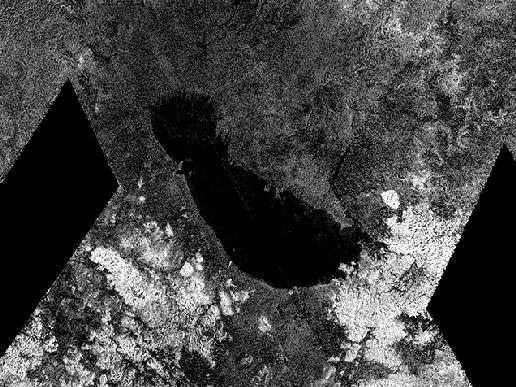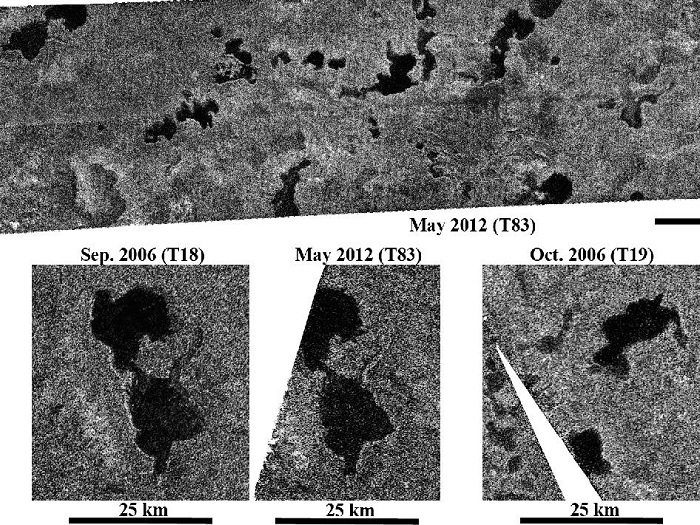.

Outline of an Ancient Sea on Titan
This image from NASA's Cassini spacecraft shows an ancient southern sea that used to sprawl out near the south pole of Saturn's moon Titan. In an annotated version, the red outline traces the ancient shoreline. Within this basin is the largest present-day lake in Titan's southern hemisphere, Ontario Lacus. Ontario Lacus appears black, indicating it is filled with liquid.
This image was obtained by Cassini's radar instrument on July 2009 and January 2010. Several images have been stitched together. By analyzing these images, scientists estimate the ancient sea was possibly as large as 300 by 170 miles (475 by 280 kilometers) across and likely less than a few hundred feet (meters) deep. Ontario Lacus is about 80 by 235 kilometers across, and probably at least 30 feet (10 meters) deep at its center. Seas may have covered large parts of the southern hemisphere less than 50,000 years ago.
Titan, Saturn's largest moon, is the only place besides Earth in our solar system that hosts large open bodies of liquid. At the cold temperatures of Titan, about minus 290 degrees Fahrenheit (94 kelvins), that liquid is not water, but methane and ethane. Over one hundred lakes and three seas are seen at the north pole of Titan, while the south pole only has a few small lakes. Scientists have suggested that cycles analogous to Croll-Milankovich cycles on Earth cause long-term cyclic transfer of liquid hydrocarbons from pole to pole, with the north pole now containing the bulk of the liquids. Less than 50,000 years ago, the cycle would have been reversed, suggesting that the south polar region should contain remnants of southern seas.
The Cassini-Huygens mission is a cooperative project of NASA, the European Space Agency and the Italian Space Agency. NASA's Jet Propulsion Laboratory, a division of the California Institute of Technology in Pasadena, manages the mission for NASA's Science Mission Directorate, Washington, DC. The Cassini orbiter was designed, developed and assembled at JPL. The radar instrument was built by JPL and the Italian Space Agency, working with team members from the United States and several European countries.
.

Titan's Lake District, One Season Later
These images obtained by NASA's Cassini spacecraft show Titan's stable northern lake district. Cassini's radar instrument obtained the recent images on May 22, 2012. It observed some previously unseen regions but also some regions containing lakes that were last observed about six years-nearly one Titan season--ago. This marks the longest time interval between lake observations in the northern hemisphere.
The top image here shows part of the radar swath from May 22, 2012, centered near 79 degrees north latitude, 58 degrees west longitude, and about 220 by 47 miles (350 by 75 kilometers) in dimension. At the bottom, parts of this image are compared with those obtained in 2006. (The images appear slightly different from previous releases because they use a new filtering technique). In 2006, it was winter in the northern hemisphere and the lakes were in the dark. Although Titan spring began in 2009 and the sun has now risen over the lakes, there is no apparent change in lake levels since the 2006 flybys, consistent with climate models that predict stability of liquid lakes over several years. This shows that the northern lakes are not transient weather events, in contrast to the temporary darkening of parts of the equator after a rainstorm in 2010 (PIA 12819).
Changes in lake levels may still be detected later in the mission as Cassini continues to observe these high northern latitudes into the beginning of summer in 2017. At that point, the sun may cause evaporation. However, the lack of significant change over six years sets important constraints for climate models and the stability of liquids on Titan. Illumination is coming from the bottom.
The Cassini-Huygens mission is a cooperative project of NASA, the European Space Agency and the Italian Space Agency. NASA's Jet Propulsion Laboratory, a division of the California Institute of Technology in Pasadena, manages the mission for NASA's Science Mission Directorate, Washington, DC. The Cassini orbiter was designed, developed and assembled at JPL. The radar instrument was built by JPL and the Italian Space Agency, working with team members from the United States and several European countries.
.

Titan's Hot Cross Bun
NASA's Cassini spacecraft obtained this image of a feature shaped like a hot cross bun in the northern region of Titan (left) that bears a striking resemblance to a similar feature on Venus (right). The Titan image was obtained by Cassini's radar instrument on May 22, 2012. The bun is located at about 38.5 degrees north latitude and 203 degrees west longitude. This image is taken from a longer radar swath, which is about 3,200 miles (5,200 kilometers) long and about 400 miles (600 kilometers) at its widest.
The circular feature shown, which looks like a giant hot cross bun, is about 43 miles (70 kilometers) in diameter with near-perpendicular markings about 37 miles (60 kilometers) wide, meeting at its center. The illumination for this synthetic aperture radar image is from the right. Similar features are seen on other planets. In a synthetic aperture radar image of Venus by NASA's Magellan spacecraft, this radar-bright circular-shaped region of 20 miles (30 kilometers) across lies at the summit of a large volcano called Kunapipi Mons (at about 33.3 degrees south latitude and 85.5 degrees west longitude on Venus). This comparison leads to the interpretation that the Titan crosses are also fractures caused by uplift from below. Steam often causes the top of bread to lift and stretch, but on Titan some other force, such as rising cryomagma, may have uplifted the surface, leading to the crossed cracks.
The Cassini-Huygens mission is a cooperative project of NASA, the European Space Agency and the Italian Space Agency. NASA's Jet Propulsion Laboratory, a division of the California Institute of Technology in Pasadena, manages the mission for NASA's Science Mission Directorate, Washington, DC. The Cassini orbiter was designed, developed and assembled at JPL. The radar instrument was built by JPL and the Italian Space Agency, working with team members from the United States and several European countries.
.
Quelle: NASA
